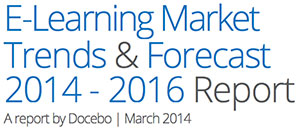
The U.S. company Docebo (dedicated to providing E-learning services) published in March of this year a study that suggests that it is estimated that $51 billion will be invested in 2016 in e-learning worldwide. Although this study is intended largely to investors, the information provided is interesting.
The report distinguishes three components or sub-sectors of e-learning: Content, authoring tools, and virtual learning platforms.
The worldwide growth for all three components combined is 7.6% but some regions will grow more: Asia (17.3%), Europe (16.9%), Africa (15.2%) and Latin America (14.6%).
There is a great demand for self-paced e-learning (in which learners study at their own pace, without a fixed starting date or regularly scheduled assignment completion dates).
Also, there is growth in the demand for LMS (learning management systems). Moodle is still one of the most commonly used platforms, but the percentages of use are highly dependent on the sector (education, government, business).
Packaged content is also needed, imported from abroad or outsourced in various regions.
The research also presents a quick look at e-learning in higher education and K-12 education. For example, they cite the study by Babson Survey Research Group, in which it is estimated that 6.7 million American college students enrolled in at least one online course in 2011. That is, nearly a third of all students enrolled in higher education in the U.S.A.
According to the Universia network, "e-learning should have a greater presence in educational institutions and companies, as well as in homes of those who conduct online courses... For this reason, it is also likely that in the next three years the number of people using this modality for educational purposes will increase substantially."
More information:

